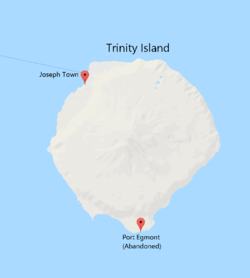Port Egmont
| Nation: | South Sea Islands |
| Population: | None |
| Predominant language: | None |
|
| |
| Main roads: | None |
| Major districts: | Hull, Brigg |
|
| |
| Current mayor: | None |

| |
| Map versions: | N/A |
Port Egmontis a ruin and former settlement on the the southern tip of Trinity Island, South Sea Islands.
Established on May 31st 1501, it was the first settlement and national capital, before being abandoned completely in 1504 when the inhabitants relocated to Joseph Town en masse.
History
Establishment
Following the Journey of the Frozen Tears and the subsequent landings in Discovery Bay, early settlers constructed primitive homes using wood salvaged from the SS.Endeavour. The close proximity to the icecap and the subsequent challenging climate severely restricted the availability of building materials and made agriculture all but impossible. For that reason, the city remained relatively small in size and population, reaching a maximum population of 520 in 1503.
Surveying Work
The city's growing population and the harsh weather were driving factors behind surveying work undertaken during 1502 and 1503, with the ultimate goal being the establishment of a new settlement in more favourable location. While the landscape of Trinity Island's rugged interior initially proved difficult for the survey parties to cross, by 1504 surveyors had discovered Nightingale Bay on the island's northern coast.
While still heavily impacted by the island's proximity to the icecap, Nightingale Bay proved to have a much more favourable climate. Nearby accessible stone deposits were quickly located and, critically, the sea was not subject to winter freezing. The area was identified as the preferred location for a new settlement in late 1503.
Abandonment
In 1504 the population of Port Egmont relocated to Nightingale Bay, establishing Joseph Town upon their arrival. While many of Port Egmont's structures were left in tact, the wooden buildings quickly deteriorated without maintenance.
Today, a bronze plaque marks the spot where the settlement once stood, and archaeologists have also identified the remains of a number of wooden posts preserved in the permafrost.